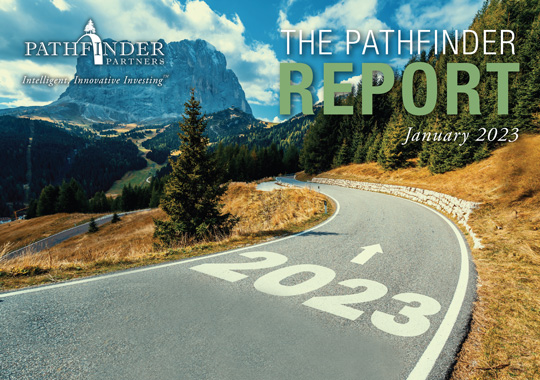Finding Your Path
What Goes Up, Must Come Down (To Earth)
By Lorne Polger, Senior Managing Director

The book has now closed on an eventful 2022.
We certainly had a whipsaw year, a tale of two cities. The first half of the year was the end of arguably the greatest boom in the history of the apartment business. Multifamily rents continued to soar. Construction starts and development projects were at all-time highs. Capitalization (cap) rates settled (for a time) at all-time lows. Pathfinder took advantage of it. We sold one of our properties in Tempe last May to an institutional investor at a 2.8% cap rate, the lowest cap rate we have ever achieved on the sale of a property.
But then, whoops, the “I” word kicked in. Inflation. Just like we had predicted, after the government threw money out of helicopters like it was free (except it really wasn’t). We found the pronouncements we heard from many of our friends in the brokerage community in the spring of 2022 (“it doesn’t matter that interest rates are going higher, rents will keep on growing and that will cover the additional interest cost”), a little hard to believe. And eventually, so did the market. Sales, which were on a tear during the first half of the year, fell off a cliff during the second half. Some of the numbers are quite staggering. For example, while total sales volume for the Phoenix market was down 19% for 2022 as compared with 2021, year-over-year sales volume for December was down a whopping 83%. Denver? Down 88% for November. Similar story in many of our other markets.
We experienced a similar story with rents. 2021 and the beginning of 2022 had unprecedented rent growth across the U.S. Covid put a pause on rent growth in 2020, but the huge pent-up demand for apartments changed that beginning in 2021. And that surge lasted through part of 2022. The national year-over-year average rent growth in 2021 was up 13.5%, more than double any previous year. Some markets were even stronger. Phoenix was up over 25%. Denver, Seattle, and Portland were all in the mid-teens. Keep in mind that historically, Pathfinder has underwritten annual rent growth in the range of 3-4%. But by the spring of 2022, we started to see the signs of a looming slowdown. In some cases, what was meteoric growth of over 20%/year, slowed down to a trickle or even regressed. Occupancy also showed signs of softening.
If you look at annualized statistics, the numbers do not really tell the story of what happened in 2022. Annually, the average multifamily asking rent rose across the U.S. by 6.2%. By historical context, that was strong performance. The year started as a continuation of 2021, with rents rising through the normally tepid first quarter. But the spring blooms began to wilt. As the economy and demand began to cool in the late spring, rents began their inevitable deceleration. What were $200 or in some cases even $400 increases on lease trade-outs for us slowed to $50 increases, and with some properties, flat rents. And as the year progressed, rent growth slowed significantly. Nationally, asking rents fell 0.6% in last year’s fourth quarter.
Frankly, we don’t think that is a bad thing. Hyperinflation hits everyone hard. 20-30% annualized rent growth, while a great story for a syndicator trying to raise money for a specific deal, results in unaffordability for the masses, followed quickly by on an onslaught of political backlash (most notably of late, in the form of both eviction restrictions and rent control measures). Having nearly half of Americans spending an inordinate amount of their income on housing is not healthy for these families, for the real estate industry or for the U.S. economy.
We think 2023 is going to be quite different. This year, we believe the markets will calm down, and behave in a more traditional manner. Most economists predict annual rent growth in the 3% range, which would be back to a historical average. National forecaster Yardi Matrix recently revised their annual apartment rent forecast down to 3.1% from 3.5% but noted that the market has positive drivers. They expect the growth to occur in the first two to three quarters of the year. Further, they believe that a potential recession would not be particularly deep or lengthy. A far different situation from the outsize rent growth we experienced over the last two years. The demand-supply equation has changed. Demand for apartments is moderating from record levels as the economy cools, excess savings are depleted, affordability is stretched, and the post-pandemic migration is played out.
 At the same time, 2023 will be an extraordinarily strong year for new supply. According to brokerage firm Berkadia, more than 565,000 new apartment units will come online in 2023, the largest number in 50 years, and over 150,000 more units than came online in 2022. The highest concentrations of new deliveries will be in the sunbelt states, which will have to dampen the increases in rent growth there.
At the same time, 2023 will be an extraordinarily strong year for new supply. According to brokerage firm Berkadia, more than 565,000 new apartment units will come online in 2023, the largest number in 50 years, and over 150,000 more units than came online in 2022. The highest concentrations of new deliveries will be in the sunbelt states, which will have to dampen the increases in rent growth there.
How will the markets absorb all those new deliveries? Slowly, we believe. And that will be the tale of two cities between Class-A and Class-B housing stock moving forward. At Pathfinder, we continue to favor suburban, Class-B apartments. With rents clearly decelerating now, the market is waiting to see where the bottom could be. We think we are at or near the bottom in Class-B – which represents a tremendous value when compared with Class-A properties (about 20% less, in our markets) and an unbelievable value compared with new, Class-A properties (60% less in our markets!). While we have seen some rent reductions and concessions of late, we have typically seen renter demand kick back in once we hit prime leasing season in the spring.
The tale of the other city for 2023 is Class-A. With so much new supply coming online, we expect these properties will have much slower lease-ups than expected. That, in turn, will result in significant rent concessions in that space. And the trickle has already turned into a stream (not predicting a raging river yet, but we’ll see how it plays out over time). New deliveries in some of our markets are giving away up to ten weeks for free on a new one-year lease (which is almost a 20% concession in total annual lease payments). Austin, Orlando, Nashville, and Phoenix come to mind as markets with the highest vulnerability. That said, many markets will probably experience essentially flat rents in the best properties, and price backtracking wouldn’t be surprising.
And the difference in new Class-A rents and Class-B rents is significant. The gap between new construction Class-A rents in Seattle and Class-B rents? About double. Phoenix clocks in at a 77% differential, Denver at 72%. Those are big spreads and give owners like Pathfinder a comfortable margin of safety knowing that we are not going to lose tenants to those types of buildings (and by the way, we’re probably not going to lose many to homeownership either, especially with mortgage rates hovering in the mid-6’s today). Couple that with long-term, low leverage, fixed-rate debt across almost all our properties, and we’re sleeping pretty well these days.
And that is essentially the difference between owners who are in it for the long-term and have that same view on investing, and those that are built more for the quick fly. The former can ride the waves up and down, since that is an inevitable part of market cycles, whether in real estate, stocks, or bonds. Build a portfolio for safety and the bumps don’t hurt too bad. Build it for the short-term and the bumps can be painful. Over the next year or two, some won’t survive the bumps, at least not without getting badly bruised along the way.
Lorne Polger is Senior Managing Director of Pathfinder Partners. Prior to co-founding Pathfinder in 2006, Lorne was a partner with a leading San Diego law firm, where he headed the Real Estate, Land Use and Environmental Law group. He can be reached at lpolger@pathfinderfunds.com.
Share this Article
IN THIS ISSUE
PATHFINDER PARTNERS INCOME FUND, L.P.
A Stablized Multifamily Fund
CHARTING THE COURSE
Is This an Economic Pivot Point?
FINDING YOUR PATH
What Goes Up, Must Come Down (To Earth)
GUEST FEATURE
An Article about Nothing
GUEST FEATURE
Resiliency: An Important Driver of Value for Businesses and Investors
ZEITGEIST
News Highlights
TRAILBLAZING
Hiawatha, Seattle, WA
NOTABLES AND QUOTABLES
Integrity
